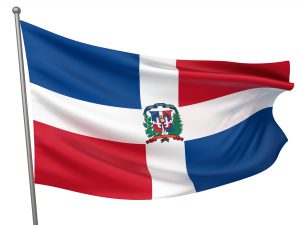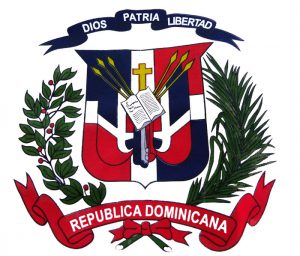
Patriotic Symbols
Patriotic symbols represent for all Dominicans a close connection with our history and the fight for independence. The flag, the seal and the National Anthem are symbols of the highest importance for the Dominican identity.
The Flag
 With quartered red and blue sections, separated by a white cross, the national banner was lifted for the first time in the Cibao on March 4, 1844. Days before, on February 27, national independence had been declared after 22 years of Haitian control.
With quartered red and blue sections, separated by a white cross, the national banner was lifted for the first time in the Cibao on March 4, 1844. Days before, on February 27, national independence had been declared after 22 years of Haitian control.
The first national flag featured the same color distribution as the Haitian flag: the blue sections above and the red below. Later, this distribution of the sections was changed. The white cross, placed there as an expression of freedom, has remained since the original design.
Did you know? The first flags were made by various ladies of Dominican society, among them María Trinidad Sánchez, María de Jesús Piña, Isabel Sosa and Concepción Bona.
Did you know? The Dominican flag was designed by Juan Pablo Duarte and dedicated to his comrades who fought during the war of independence when he formed the secret organization La Trinitaria, on July 16, 1838. Each color is separated by a white cross, which has the Dominican coat of arms in its center. Duarte thought about the cross as a symbol of redemption, not as one of suffering, and chose the white color to display that the nation would welcome every race equally.
Did you know? The Dominican flag was lifted for the first time on March 4, 1844 in Puerta del Conde, in the capital.
Did you know? The colors of the national flag have a hidden meaning. Red represents the blood lost by the liberators; the blue exemplifies progress and liberty, and the white stands for unity and peace.
National Anthem
The first version of Prud’Homme’s verses was presented on August 16, 1883 in the capital’s weekly paper El Eco de la Opinión. 18 years had passed since the country had restored its independence lost in the annexation to Spain in 1861.
On August 17, 1883, the hymn debuted in a soirée for the national press in the Logia Esperanza de Santo Domingo. The debut was just the beginning of its popularity. For its authors, the piece had a precise objective: to heighten Dominican national sentiment in a country was recently emerging from an annexation period that revealed the strong ties many of its citizens had to Spain.
The consummation of the national anthem’s composition occurred with the transporting of the remains of the Founding Father of the country, Juan Pablo Duarte, from Caracas, Venezuela, where he died in 1876. On February 27, 1884, during the journey that brought the remains from the port of Santo Domingo to the cathedral, the anthem was played.
Prud’Homme corrected the text in 1897 and produced a final version. On June 7 of the same year, the National Congress officially proclaimed the composition to be the national anthem.
The dictator Ulises Heureaux, who saw Prud’Homme as an adversary, did not make the Congressional resolution into law. It was May 30, 1934 when the President of the Dominican Republic, Rafael Leonidas Trujillo Molina, declared the piece as the national anthem.
Article 97 of the Constitution states that “The National Anthem is the musical composition approved by Law No. 700, on the date May 30, 1934, and is invariable, unique and eternal.”
You can read more about the Dominican National Anthem here
Hear the lyrics of the Dominican National Anthem here: http://www.teoveras.com.do/wp-content/uploads/2012/05/Coro-Nacional.mp3
The National Seal
 Since its creation in 1844, the design of the seal was modified on multiple occasions by constitutions, laws and decrees. In 1913, the current seal was created.
Since its creation in 1844, the design of the seal was modified on multiple occasions by constitutions, laws and decrees. In 1913, the current seal was created.
In the center, it features a classic seal with a point at the bottom and is closed on top by an upside-down triangle with the national colors. In the foreground, there are six flagstaffs, with four gathered flags supporting an open Bible, and above it, a cross.
On the left, there is a laurel branch to represent immortality, and to the right a palm branch, a symbol of freedom. A red ribbon, which symbolizes Glory, unites the branches and over it, a red banner that reads “Dios, Patria y Libertad” (God, Country and Liberty).
Evolution of the Seal
A trophy of weapons and a snake, a laurel branch and two cannons: these were parts of the Dominican seal eliminated in the process of modification that brought with it new criteria for authorities and influential thinkers.
The first coat of arms had two exterior laurel branches. Underneath, in an arc, a snake was biting and swallowing its tail as a symbol of eternal evolution. On a third draft, the Bible was shown, and behind it a collection of weapons that included a lance and a rifle with bayonet; a saber and a bugle; and above the book hung the Dominican flag. Two more Dominican flags were centered on the second level, with a Frygian helmet at the intersection of the flagstaffs as a symbol of liberty. A wide ribbon with the words “Dominican Republic” on it occupied the lower portion and two cannons with their cannonballs were featured on either side.
In the Constitution of November 6, 1844, the cannons were replaced. In 1848, a laurel branch was replaced by a vine, which was then, in 1853, substituted with a palm leaf. The same year, the central flag was succeeded by a cross, and at the same time, the weapons and the serpent were removed and the crossed flags were increased from two to four.
The undefined use of the original seal and its variations continued until 1913, when the current design was officially approved. The Decree was issued by the government of Monseñor Noüel. The same decree specified the colors to be used: ultramarine and vermillion.
Did you know? The Dominican national seal is the only seal in the world with the Holy Bible in the center. The book is open to St. John 8,32: “And ye shall know the truth, and the truth shall make you free.”
Did you know? The national seal has gone through more than 14 design changes since its creation. In 1993 Casimiro Nemesio de Moya designed the current seal.
Learn more about Dominican National Symbols: http://www.gob.do/index.php/pais/2014-12-16-20-48-30


